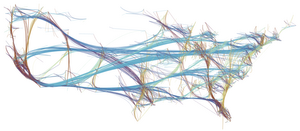Information
- Publication Type: Bachelor Thesis
- Workgroup(s)/Project(s):
- Date: September 2025
- Date (Start): March 2025
- Date (End): September 2025
- Matrikelnummer: 11776184
- First Supervisor:
Abstract
Visualizing large graphs is often challenging due to visual clutter, which obscures important patterns. While Spanner-based Edge-Path Bundling (S-EPB) is an effective technique for mitigating this issue, its CPU-based implementation is too slow for interactive use, particularly in web environments. This thesis presents a Parallel Edge-Path Bundling (P-EPB) algorithm that addresses this performance limitation by utilizing the massively parallel processing capabilities of modern Graphics Processing Unit (GPU)s through the WebGPU API.The proposed algorithm reengineers the S-EPB technique for parallel execution, with a focus on finding and then optimizing the most computationally demanding tasks: spanner construction and shortest-path calculations. A parallelized Floyd–Warshall algorithm, together with different spanner construction methods (greedy and theta-graph), is employed in implementing the P-EPB algorithm as an interactive web application.
A detailed evaluation compares the WebGPU-based P-EPB algorithm to the CPU-based S-EPB implementation. Results show that the P-EPB approach, particularly when using a theta-spanner, delivers substantial speedups on dense graphs. This work highlights the potential of WebGPU to enable high-performance, interactive graph visualization and analysis in web-based environments.
Additional Files and Images
Weblinks
BibTeX
@bachelorsthesis{ellhotka-2025-ipo,
title = "Improving the Performance of Edge-Path Bundling With WebGPU",
author = "Yannic Ellhotka",
year = "2025",
abstract = "Visualizing large graphs is often challenging due to visual
clutter, which obscures important patterns. While
Spanner-based Edge-Path Bundling (S-EPB) is an effective
technique for mitigating this issue, its CPU-based
implementation is too slow for interactive use, particularly
in web environments. This thesis presents a Parallel
Edge-Path Bundling (P-EPB) algorithm that addresses this
performance limitation by utilizing the massively parallel
processing capabilities of modern Graphics Processing Unit
(GPU)s through the WebGPU API. The proposed algorithm
reengineers the S-EPB technique for parallel execution, with
a focus on finding and then optimizing the most
computationally demanding tasks: spanner construction and
shortest-path calculations. A parallelized Floyd–Warshall
algorithm, together with different spanner construction
methods (greedy and theta-graph), is employed in
implementing the P-EPB algorithm as an interactive web
application. A detailed evaluation compares the
WebGPU-based P-EPB algorithm to the CPU-based S-EPB
implementation. Results show that the P-EPB approach,
particularly when using a theta-spanner, delivers
substantial speedups on dense graphs. This work highlights
the potential of WebGPU to enable high-performance,
interactive graph visualization and analysis in web-based
environments.",
month = sep,
address = "Favoritenstrasse 9-11/E193-02, A-1040 Vienna, Austria",
school = "Research Unit of Computer Graphics, Institute of Visual
Computing and Human-Centered Technology, Faculty of
Informatics, TU Wien ",
URL = "https://www.cg.tuwien.ac.at/research/publications/2025/ellhotka-2025-ipo/",
}

 thesis
thesis

